Start Exploring Keyword Ideas
Use Serpstat to find the best keywords for your website
SEO Writing Masterclass - 21 Tips to Rank #1

Content marketing is one of the best ways to attract visitors to your website and convince them to use your products and services.
But if your content is just sitting on your website without getting any traction, it can’t help your business grow.
You need your content to rank high on Google to drive qualified traffic to your website.
And that’s where SEO writing comes in!
By creating content for search engines and humans, you can hit that sweet spot of ranking high on Google, attracting the right kind of audience, and converting them into customers.
I’ve written hundreds of articles that rank on the first page of Google as part of my SEO agency, MintSEO. And in this article, I’ll help you do the same by explaining literally everything you need to know about SEO writing.
Contents:
- What is SEO Writing?
- 21 SEO Writing Tips to Rank #1 on Google
- Start From Keywords
- Optimize Your Content With Keywords
- Match Search Intent
- Create Headlines That Drive Clicks
- Optimize for Featured Snippet
- Write for Humans AND Search Engines
- Avoid Keyword Stuffing
- Make Your Content Scannable
- Focus on Content Velocity
- Interlink as Much as Possible
- Use Images & Illustrations
- Link to Authoritative Sources
- Add an FAQ Section
- Build Backlinks to Key Pages
- Keep Things Simple
- Create an Effective Introduction Section
- Use ChatGPT for Content Inspiration
- Use Bucket Brigades to Make Your Writing Flow Well
- Interlink Your Fresh Content
- Use Content Outlines
- Re-Optimize Your Content
- Conclusion
What is SEO Writing?
SEO writing is the practice of creating content optimized to rank high on search engines. This process involves using keywords, interlinking, and using other optimization techniques to improve your content’s visibility on Search Engine Results Pages (SERPs).
Essentially, SEO writing aims to strike a balance between pleasing search engine algorithms and providing genuine value to the readers.
Creating content that hits that sweet spot can help you improve your online visibility, drive more visitors to your website, and boost the bottom line of your business.
21 SEO Writing Tips to Rank #1 on Google
SEO is not an exact science, but these tips can definitely help you create content that ranks #1 on Google.
Here’s what you need to know:
#1. Start From Keywords
Keywords give you valuable information about who your customers are and what they search for.
They can help you determine which topics to write about and how to optimize your SEO strategy for the best results.
However, most newbie SEO writers make the mistake of creating content first and then optimizing it for a keyword they think is relevant.
This approach can completely ruin your chances of ranking on Google.
When creating SEO-friendly content, your #1 goal is to meet search intent.
Meaning, your article should be an answer to a question, not your personal thoughts and opinions.
The right approach to SEO writing is to start by researching your target keywords, and THEN creating content around them, not the other way around.
#2. Optimize Your Content With Keywords
Optimizing your content with keywords helps search engine algorithms recognize what your content is about and rank it more favorably.
However, it’s important to mention that keyword density is no longer a ranking factor.
These days, the best practice is to include your target keyword(s) once or twice in strategic locations, such as:
- Title
- Meta Description
- Headline
- Introduction Section
- Body Text
- URL Slug
- Conclusion
Use your keyword naturally, and avoid awkward formulations that make you sound like a robot.
That way, you’ll help algorithms understand what your content is all about without breaking its flow.
#3. Match Search Intent
When it comes to content optimization, matching search intent is the most important thing.
If you don’t match search intent, you simply aren’t going to rank.
Each time someone types something into Google Search, they have a specific goal they want to achieve. Maybe they want to find the best restaurants in the area, discover energy-saving tips to minimize their utility bills or find a plumber.
Understanding search intent helps you write content that’s relevant and useful to your readers.
So, how do you discover search intent and create content that satisfies customer needs?
Simply Google your target keyword and analyze the top-ranking posts:
- What do they have in common?
- What’s the general theme of the articles?
- How are the articles structured?
- What problems do they solve?
Then, simply ensure that the content you write is in-line with whatever’s currently ranking on top.
#4. Create Headlines That Drive Clicks
A well-crafted headline can make a difference between a reader clicking through to your website or simply scrolling past it in search results.
Creating attention-grabbing, informative, and relevant headlines increases the likelihood of people clicking on and reading your content.
For example, let’s compare these two headlines:
“Top 21 Resume Tips [To Land Your Dream Job in 2023]”
VS
“Resume Guide – Best Resume Tips”
Which one would you click?
Data says it’s the first one!
If you want to create headlines that will drive more clicks, I recommend including these elements:
- Keyword – This is an SEO must!
- Numbers – There is something about numbers in headlines that makes people want to click on them.
Results – You need to include a result people can achieve from reading your article. You can see this in the example above – Top 10 Resume Tips [To Land Your Dream Job in 2023].
Year (if relevant) – Adding a year to your title shows that it’s recent, which drives more clicks.
#5. Optimize for Featured Snippet
Think of a featured snippet like a storefront display in a busy shopping district. It’s the first thing people see when looking for something specific, which makes it more likely for them to come in and check out what you have to offer.
Similarly, a featured snippet is an answer to a user’s query that appears at the top of Google search results.
And according to Search Engine Watch, featured snippets receive 35.1% of all clicks on Google. This means you can get a serious traffic boost by conquering the position “zero” on the SERPs.
So, how do you get your content to be in featured snippets?
Well, there is no precise formula. But here’s what you can do to tip the odds in your favor:
- Research and target keywords that already have a featured snippet.
- Create content that provides a clear and concise answer that matches search intent.
- Format your content in an easy-to-understand way using bullet points, tables, or numbered lists.
- Use structured data markup to help Google better understand your content.
- Make your content mobile-friendly.
- Keep your content relevant and valuable.
#6. Write for Humans AND Search Engines
SEO content writing requires a delicate balance between writing for humans and search engines.
Writing only for search engines may impress the algorithm and help you rank better. But it won’t provide useful content, and you won’t build a meaningful connection with your readers.
Similarly, writing only for humans is like creating a masterpiece of a painting and hanging it in your basement where nobody can see it.
That’s why you need to create quality content that provides real value to your audience and optimize it for search engines. Only then will you be able to reach the full potential of SEO writing, where you:
#7. Avoid Keyword Stuffing
Keyword stuffing is the practice of excessively using your keywords with the goal of better search engine rankings.
And let me say this one more time for the people in the back:
Keyword stuffing doesn’t work!
In fact, keyword stuffing can distract your readers, making them question the credibility of your content.
Think of it like using perfume. Put too much on, and it becomes overwhelming and off-putting. Use just the right amount, and it can make you (or your content, in this case) more desirable.
So, how many times are you supposed to use a keyword to rank?
Well, there is no exact number.
Simply use your keyword naturally where it makes sense without trying to cram in as much as possible.
Doing this will provide a more positive user experience, which will help you rank better on Google.
#8. Make Your Content Scannable
Most people don’t want to read your articles from start to finish. Rather, they’ll likely skim through your article to find something specific that they’re looking for.
That’s why it is vital to make your content scannable.
If Googlers are not able to find what they want quickly, they are likely to bounce off your website and go to your competitors instead.
You can make your content scannable by breaking up large chunks of text into smaller paragraphs, by using:
- Subheadings
- Bullet points
- Numbered lists
- Graphics
- Content boxes
And other similar elements!
Doing that makes your content more user-friendly, which improves the overall user experience.
#9. Focus on Content Velocity
Content velocity describes how much content you publish over a set period of time.
Practically speaking, your content can’t start ranking if it’s not published online. The earlier you publish your blog posts, the faster they’re going to start climbing up the rankings.
This is why content velocity is so important - the faster you push out more content, the sooner you’ll start ranking well and driving organic traffic.
So, one of the strategies to improve your SEO content writing game is to up your content output.
That said, you should keep in mind that content quality is also important. So, publishing more content won’t help you if it doesn’t provide any value.
Now, you might be wondering how you can determine how much content to push per month. Here’s a tactic that we use at my agency:
And here’s an example:
If the total word count is 200,000 words, and you want to complete it in 6 months, you need to write 33,000+ words of content per month.
If you want to finish in 12 months, that's 16,600+ words of content per month.
#10. Interlink as Much as Possible
Interlinking is the process of linking one page to another page within the same website.
Doing this helps connect topically related content, which makes it easier for readers to find what they are looking for. Think of it like building a road network within the city – the more connected roads are, the easier it is for people to navigate and reach their destination successfully.
In addition, interlinking:
There’s no exact number on how many internal links you should have.
My personal rule of thumb, though, is to link to as many topically related pages as possible. If there’s any type of connection between two topics, then that means that they should be linked together.
#11. Use Images & Illustrations
As human beings, we are attracted to colors, images, and visual elements because we are wired to be visual creatures.
That’s why you need to add images and illustrations to your content to make it more attractive to the reader.
Visual elements can make your content more engaging and easier to understand.
For example, graphs and diagrams can help readers visualize data and better understand complex topics.

While screenshots and images are incredibly helpful when you’re writing a step-by-step guide on how to solve a specific problem.
However, you should only use images and illustrations that add more value to your content.
For example, let’s say you’re writing an article about the importance of optimizing your meta description for SEO.
Using a stock image of a person typing on a keyboard won’t add any value to your content and can distract readers from the main point of your article.
Instead, you can use a screenshot of SERPs, highlighting a well-written meta description that ranks highly for a targeted keyword. This is more relevant and provides additional value to your article.
#12. Link to Authoritative Sources
When writing SEO content, it’s vital to link to authoritative sources that back up your claims or data.
That provides evidence to support your arguments, which improves your credibility and establishes your authority.
In terms of SEO, linking to authoritative sources shows Google that your website is likely to be credible, too.
The key here, though, is to link to credible sources.
Just like you wouldn’t cite some obscure source in a research paper, you shouldn’t link to untrustworthy websites in your content. Instead, look for credible sources with verified information.
If you’re not sure if a website is trustworthy or not, you can use a no-follow tag when linking to it. That way, you can acknowledge the source without having any potential negative SEO consequences.

#13. Add an FAQ Section
Adding an FAQ section helps to answer any specific questions your audience may have after reading your article. This keeps your readers engaged for longer and provides more information about your products and services.
In addition, an FAQ section can help you target long-tail keywords that bring in more qualified traffic to your website.
And if you’re selling products or services, these long-tail keywords can be real goldmines.
So, how do you write an effective FAQ section?
You start by typing your keyword into Google and seeing what questions people ask about that specific topic.

If your content doesn’t already answer these questions, you can create an FAQ section at the end of your article as an H2 header and answer them there.
Bonus points: you can also check forums like Reddit or Quora to discover more common questions about your topic.
Alternatively, you can use a dedicated tool like AlsoAsked:
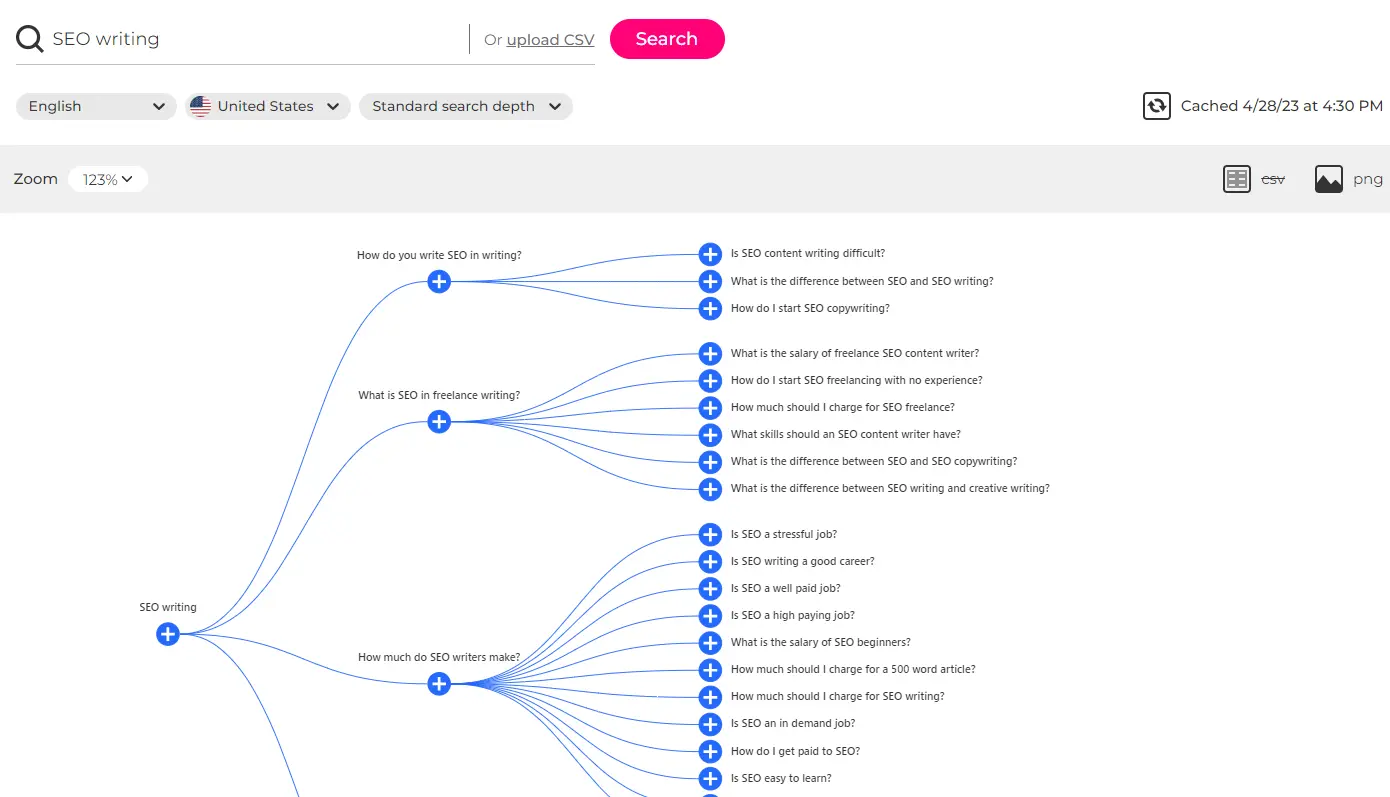
#14. Build Backlinks to Key Pages
Backlinks, or links from one website to a page on your website, are still a major ranking factor.
In competitive niches where most websites have top-notch content, the quality and quantity of backlinks can be the main differentiating factor for high search engine rankings.
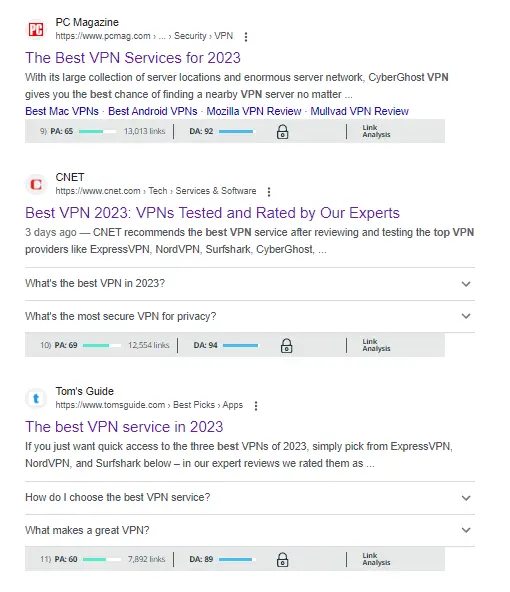
That’s why, if you are in a highly competitive niche (CBD, VPN, etc. ), you should be proactively focused on building backlinks to your key pages. You can use email relay and other SendGrid alternatives to build effective backlinks via email marketing.
Without quality backlinks, at best, it’ll take you ages to rank, and at worst, you’ll never actually rank high enough.
Just keep in mind that quality is often more important than quantity when it comes to link-building. So, one backlink from a high-authority website is more valuable than 20 backlinks from spammy websites.
#15. Keep Things Simple
People looking for information on Google are not looking to read the next William Faulkner.
They don’t have time to spend on something complex; they want a brief, simple explanation or answer to their question.
So, unless you're writing long-form history pieces, you should use simple language, keep your sentences short, and avoid unnecessary jargon.
The best way to simplify your SEO writing is to run your content through a Hemingway App and make sure your content is easy to understand by a fifth grader.
#16. Create an Effective Introduction Section
The introduction section is SUPER important because it convinces readers that your content is worth their time.
If your attention-grabbing headline convinces someone to click on your article, but the intro section doesn’t pull them in, they are likely to go back and read a competitor’s article.
So, how do you create a compelling introduction?
I like to keep things simple and follow the PAS formula.
PAS stands for Problem, Agitate, and Solve. It aims to grab the reader’s attention and engage them using a three-step process:
- Problem: Identify the problem or pain point your audience has to capture their attention and create a sense of empathy.
- Agitate: Agitate the problem by describing the negative outcomes of not solving it. This intensifies the reader's desire to find a solution.
- Solve: Present the solution to help the reader overcome their problem.
Here’s an example of the PAS formula for an introductory section of an article talking about the importance of optimizing website load speed:
Problem: Nothing kills your user experience like a slow website load speed.
Agitate: In fact, research shows that two out of three users will abandon a website if it takes more than three seconds to load. This decreases conversion rates, kills your revenue, and impacts your search engine rankings.
Solution: Fortunately, you can decrease your website loading speed by optimizing code, decreasing image size, and reducing HTTP requests. In this article…
#17. Use ChatGPT for Content Inspiration
ChatGPT won’t be able to create content that’s ready to publish for you.
That said, it CAN help speed up your content-writing process.
In fact, here’s what ChatGPT says about how it can help SEO writers produce better content:
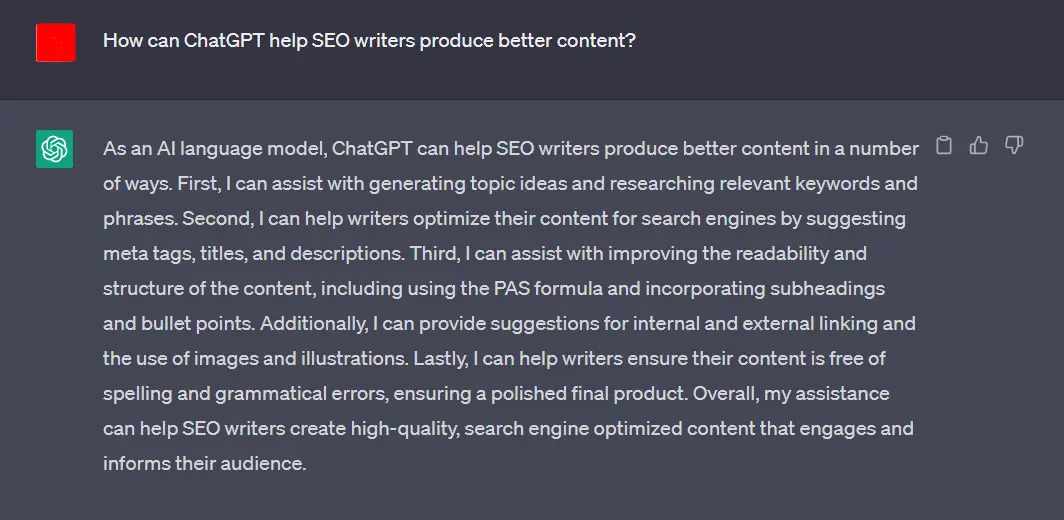
Since ChatGPT is so versatile, there is basically no limit to how you can use it. For example, you can create questions for an FAQ section or write an effective introduction using the PAS formula.
Here’s an example of an introductory section created by ChatGPT following the PAS formula:
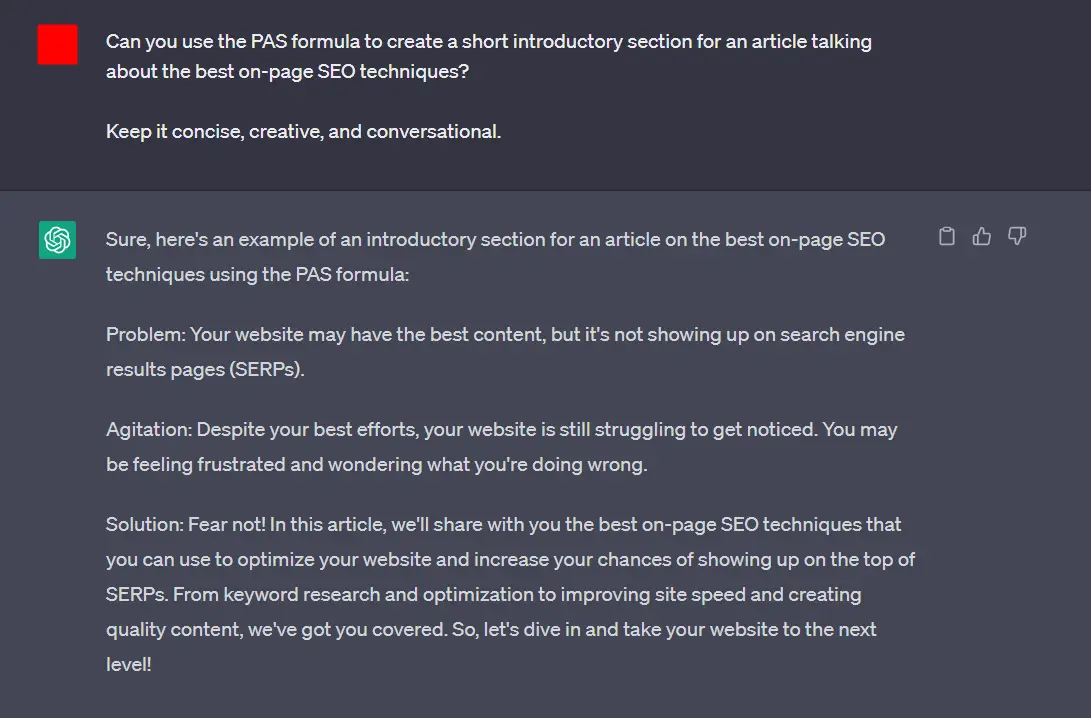
#18. Use Bucket Brigades to Make Your Writing Flow Well
Bucket brigades are phrases and sentences that improve flow and hook the reader to keep reading.
Just like a bucket brigade would carry a bucket of water along the human chain to put out a fire, bucket brigades in SEO writing shift the reader’s attention from one paragraph to the next.
The goal is to improve flow and readability, which ensures better engagement and prevents reader fatigue.
So, how do you keep your readers hooked using bucket brigades?
One way is to ask a short question like the one above.
You can also use short phrases or statements like the ones below.
- “Here’s the kicker”
- “Here’s why that’s important”
- “Let me explain”
- “You won’t believe what happened next”
#19. Interlink Your Fresh Content
Want to get your freshly published content to rank better?
Here’s what you have to do:
Go through your old (topically related) blog posts and add links to the new article you just published.
This’ll carry over some of the backlink equity from your older posts to your newer ones, allowing your fresh articles to rank better and faster.
#20. Use Content Outlines
A content outline is a document that outlines the structure and main ideas for a piece of content you’re looking to write.
It’s like a road map for your SEO writing team that ensures they create top-quality content that can rank well on search engines.
So, what makes a good content outline?
Here’s what I like to include in all of my content outlines:
- The title
- URL
- Clear heading structure
- Headings and subheadings
- Word count limit
- Inspirational articles about the topic
- (Optional) Specific bits of information I want to be included in the article
By including these elements in your content outline, you ensure that the end product meets your goals and aligns with your SEO strategy.
Here’s an example of a well-written content outline:
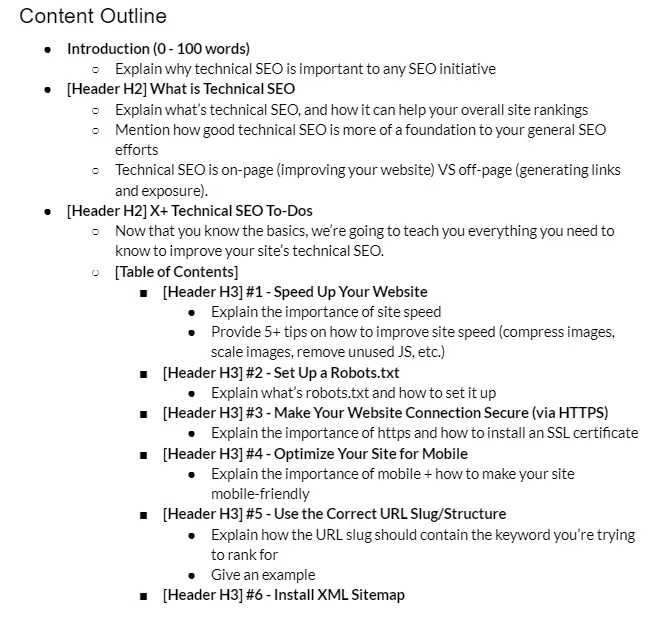
#21. Re-Optimize Your Content
Publishing your content shouldn’t be the end of your SEO efforts. In fact, there is likely more you can do to optimize it.
A few months after publishing a blog post, run it through Google Search Console:
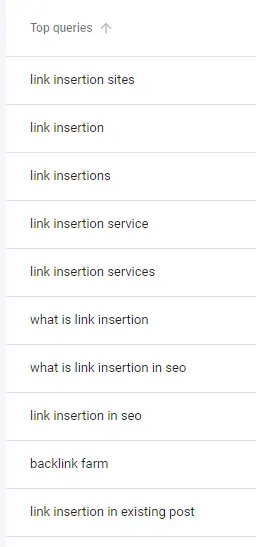
You’ll get a list of keywords that the article is ranking for.
From here, pick out keywords you HAVEN’T mentioned in your article so far, and sprinkle them throughout the content to re-optimize it.
This’ll help your content rank better for these exact keywords.
Conclusion
And that’s everything you need to know about SEO content writing to rank #1 on Google in 2023!
Remember, writing quality content has never been more important for SEO.
So, follow these tips to write better content and start ranking high on Google and other search engines.
Discover More SEO Tools
Text Analysis Tool
Unlock the power of your text data with our advanced Text Analytics Tools
AI Content Detection
Ai Content Checker – realize if the text is AI-generated
AI Text Generator
Try our AI Content Writer tool and streamline your content creation process
AI Content Tools
AI Content Marketing Tools – simplify and optimize the content creation process
Recommended posts
Cases, life hacks, researches, and useful articles
Don’t you have time to follow the news? No worries! Our editor will choose articles that will definitely help you with your work. Join our cozy community :)
By clicking the button, you agree to our privacy policy.